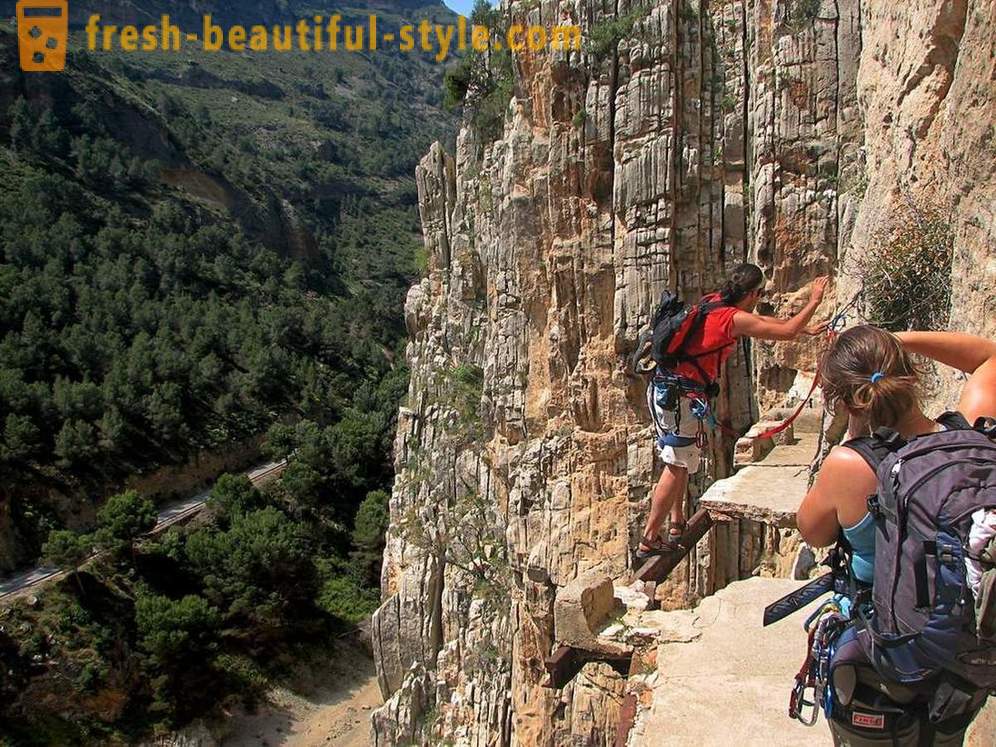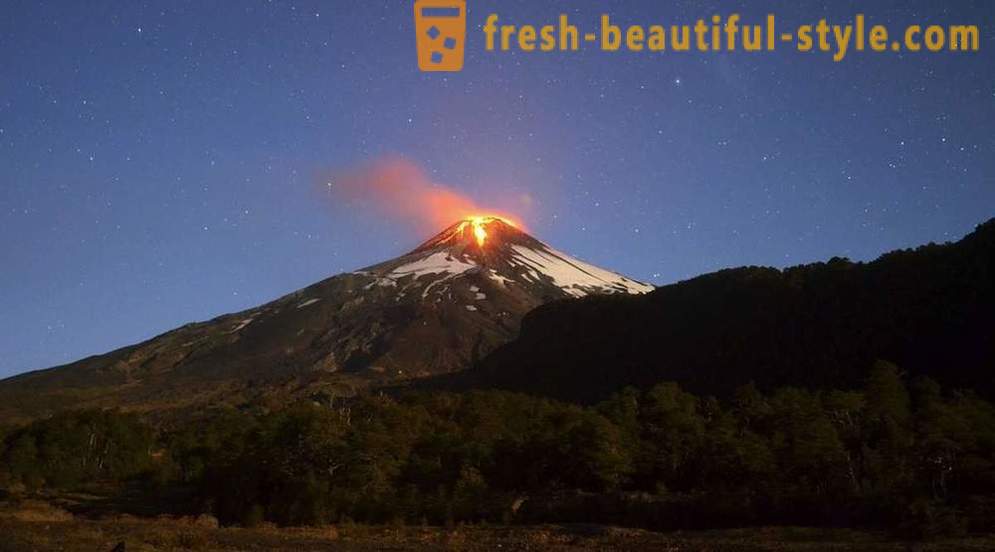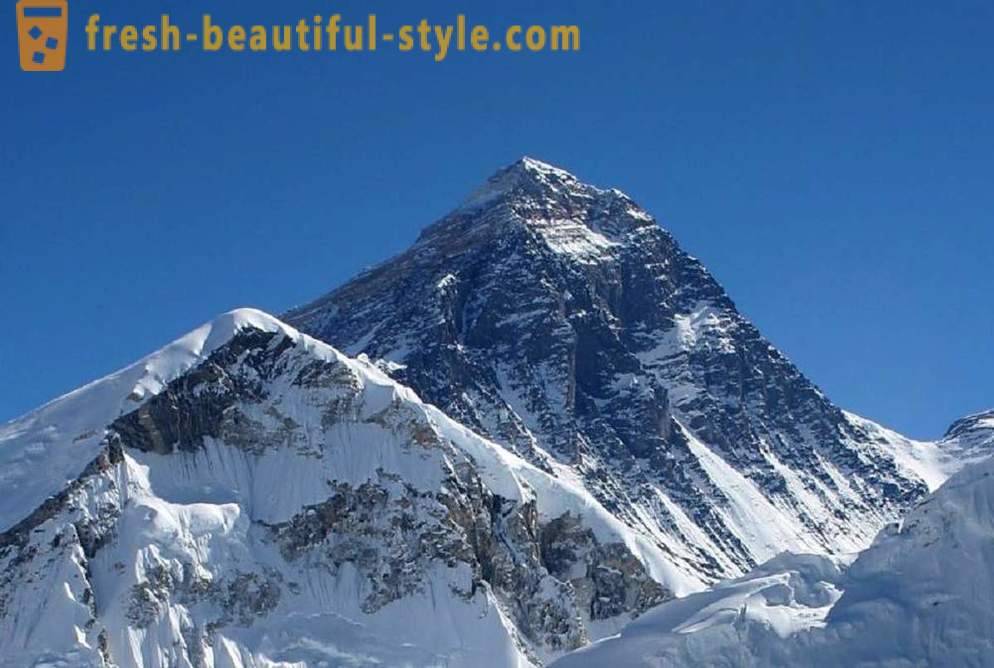10 of the most extreme places on the planet

Do you know where the most extreme places on the planet? But in Russia? Read the post until the end and find out.
№10. Ennedi Plateau, Chad, Africa
Ennedi - a plateau of sandstone in the Republic of Chad, surrounded by the sands of the Sahara. Ennedi plateau - one of the wonders of nature.
To get here is very problematic due to a number of factors: lack of developed hiking trails, a thriving gang violence among the local population that lives in poverty, political unrest. Previously there in Ennedi could only join the caravan, but now here become popular off-road safaris.
But all the difficulties pale into insignificance when you get to the plateau of Ennedi. Rocks sandstone height of 120 m, the natural arch balancing stones, old petrogliphs on rocks.
Arches in the Ennedi plateau for a long time tried to conquer dozens of climbers from around the world, and only in 2010, a group of climbers led by Mark Synnott managed to climb to the highest of them.

№9. Danakil, Ethiopia / Eritrea, Africa
Danakil - a desert in the north of Ethiopia and Eritrea's southeast. Desert area 100 000 km2. Afar inhabited by people who deal predominantly salt extraction.
High temperature, low humidity, toxic fumes, breaks from earthquakes, sulfuric lake makes this place dangerous for tourists.
However, in spite of all these dangers, the Danakil desert is a popular tourist attraction. To those who dared to visit the Danakil, great views depicting cosmic, extraterrestrial landscape.

№8. Chernobyl, Ukraine
Everyone has heard about the disaster at the Chernobyl nuclear power plant, which occurred April 26, 1986. Events in the aftermath of the explosion of a nuclear explosion began immediately after the accident and continues to this day.
Once the level of radiation in the vicinity of the station down, the Chernobyl exclusion zone is a subject open to the public. The first tourists appeared in the 30-km exclusion zone in the middle of the 90s, when the radiation level dropped significantly.
We began to emerge dozens of travel companies that organize excursions in the Exclusion Zone. In 2002 he published a UN report saying that from now on it was possible to be in the exclusion zone without any harm to the human body. Starting this year, the number of tourists visiting the exclusion zone, it was constantly grow by an average of two thousand per year. "Forbes" magazine in 2009 called the Chernobyl exclusion zone of the most "exotic" destination for tourism in the world.
Yet it remains a dangerous place, and when you visit you need to follow some rules Exclusion Zone:
• Do not move around the area without a guide.
• Visitors are required to wear only closed, fitting all body clothes.
• Avoid outdoor smoking and eating.
• Do not touch the buildings and facilities, as well as plants.
• It is not recommended to sit down and put all items on the ground.
• It is not recommended to drink water from land-based sources in the territory of the Exclusion Zone.
• Never stand and take out of the exclusion zone of any items.
Upon exiting the zone is carried out at a checkpoint monitored. In the case of high-level radioactive contamination of items subject to seizure. Despite the decline in the level of radiation, visit the exclusion zone is still associated with health risks. Tour organizers are not responsible for the health of visitors, so before entering the exclusion you will be required to put the zone signature of their agreement with this point.

to
№7. Vostok Station, Antarctica.
Station "Vostok" - the Russian Antarctic research station. This unique station founded December 16, 1957. It is located in the center of the continent, the ice and snow. The thickness of the ice under the station 3700 m.
Station "Vostok" - a symbol of inaccessibility. Station is located 1253 km from the South Pole and 1260 km from the coast of the sea. 120 days here continues polar night - from late April to late August. The population of the station is not more than 40 people.
Low temperatures, height of more than three kilometers above sea level, total isolation from the world in winter, make it one of the most uncomfortable for human habitation places on Earth. Despite the difficult conditions, life in the "East" does not stop even at -80 ° C. Scientists are exploring the unique subglacial lake, which is located at a depth of four kilometers.
July 21, 1983, is the absolute minimum temperature recorded was -89.2 ° C.

№6. Tiger Temple, Thailand
Tiger Temple - a Buddhist monastery in the west of Thailand. Founded in 1994 by abbot Pra Acharn Phusi Kanthitharo as a forest monastery and shelter for wild animals, among which there were a few tigers.
Go close to these ferocious predators, feed them and stroke could only Tiger Temple. First cub brought to the temple in 1999. Monks out of the beast, and he get along well with people, even as adults. The temple is home to over 130 tigers.
Despite Taming Tigers, took place and accidents. Time of the Tigers clawed tourists time.
But the May 30, 2016 the Thai police and representatives of the Department of National Parks, Wildlife and Plant Conservation have started to take out all the tigers from the monastery. During this operation, the veterinary office of the monastery was found about 40 dead tigers. The monastery was accused of tiger trade on the black market.

№5. Mountain trail El Caminito del Rey, Spain
El Caminito del Rey is located on the slope of a cliff in the village of El Chorro in Malaga, Spain. Its recently opened after reconstruction. They shut down the most dangerous path in the world after the death of 5 people who were trying to pass through it in 2000.
The construction consists of concrete and driven into the rock spikes and rails. The road is located on a very large distance from the ground, its length is 3 km, width of 1 meter.
The trail was built in the period from 1901 to 1905 for the purpose of transportation of construction materials to workers at plants and waterfalls Chorro Gaytaneho. The name of "Caminito del Rey" after she received the visit of King Alfonso XIII, who was on it to place the inauguration of the dam the event in 1921. Over time, metal supports and concrete had deteriorated and needed reconstruction of the trail.
Despite the official ban on the visit, there were extreme athletes who still held by the Royal path, using safety equipment. The Internet is a video dedicated to the passage of such extreme trails.
The trail was opened March 29, 2015 and is mentioned in the list of best new attractions guide Lonely planet.

№4. Volcano Villarrica, Chile
Villarrica - Chile's most active volcano, and one of the most active on the South American continent. It is located in the southern Andes in the homonymous National Park, overlooking the lake of the same name.
The height of the Villarrica -. 2847 m It has a rich history of recorded eruptions. The volcano is part of the caldera - a large basin - which was formed 3500 years ago. In addition to the Villarrica in the basin, there are about 30 cinder cones and volcanic fractures. Villarrica Volcano attracted tourists not only for its beauty and strength, but also the fact that you can go skiing and snowboarding.
Active volcanoes themselves are extreme places to visit, but for 10 000 dollars, you can make your visit to the volcano is still extreme and arrange bungee jumping from a helicopter directly above the volcano. The service six days including accommodation in a hotel, meals, helicopter flight over the Villarrica and equipment.

№3. Everest, Nepal / Tibet
Every year, climbers from all over the world are trying to conquer the highest mountain in the world - Mount Everest. tops height - 8848 meters. When climbing climbers face the following difficulties: lack of oxygen in air, low temperature, strong wind, the threat of avalanches and others.
The first official expedition came here in the 20s of XX century. The first peak was conquered in 1953 by Sherpa Tenzing Norgay and New Zealander Edmund Hillary. At various times while attempting to climb to the top 287 people were killed, but, despite this, every year there are new comers to conquer Everest.

№2. Pamplona (Running of the Bulls), Spain
The small town of Pamplona - calm and quiet place. But once a year, Pamplona has become one of the most extreme places on earth - a week Running of the Bulls.
Running of the Bulls - Spanish national custom, consisting of runaway specially issued from the pen of bulls, cows and calves. Holiday became known worldwide after Ernest Hemingway's novel "The Sun Also Rises (Fiesta)".
The most famous Running of the Bulls in Spain takes place in Pamplona during the holidays St. Fermin (from 7 to 14 July every morning). The entire route runs (from the corral to the arena on city streets) fenced wooden barriers of the boards, which are fairly easy to climb (or crawl under them). Route length - about 1 km. Anyone can run from members of local clubs of bullfighting enthusiasts to foreign tourists. Many runners are falling, and often seriously injured. The largest number of victims was recorded in 1924. This year 13 were killed and 200 people injured. In 2009, he killed 27-year-old man.
The animal rights movement to protest against the Running of the Bulls, including in the form of "Human Running of the Bulls".

№1. The island Ilha da Queimada Grande, Brazil
Ilha da Queimada Grande or Snake Island, is located in the Atlantic Ocean, 35 km south of the coast of the Brazilian state of Sao Paulo. The island of about 0, 43 km2.
The island is called a snake, because it is teeming with thousands of snakes. It is a true open-air Serpentarium. There are no homes or hotels, just let Autonomous beacon.
Here it is found one of the most dangerous snakes in the world - kopegolovy island Botrops (Bothrops insularis), which has one of the strongest poisons. Bite Botropsa causes rapid tissue necrosis, acute renal failure, gastrointestinal hemorrhage, cerebral hemorrhage death in 7% of cases.
On the island in the main inhabitants are no natural enemies, so this is the perfect place for their prosperity. Snake then breed year-round, one female can produce up to 50 individuals.
The island has no other animals as any animal immediately falls prey to snakes. They feed mainly migratory birds that sit quietly on the branches of trees, unaware of the danger waiting for them fatal.
Once the snake lived on the mainland, but people set fire to the jungle and swamp dried. Gradually snakes were driven out to the island. According to experts, Ilha da Queimada Grande and the continent joined the narrow isthmus on which the snake and moved. As a result of geological processes isthmus sank into the sea, and the island was in the disposal of toxic settlers. Snakes have repeatedly asserted their rights to the island. They threw a banana plantation in the 19th century, killed 3 lighthouse keepers. In the end, people are tired of fighting with a plague, and the Brazilian government announced Snake Island forbidden for visitors area. This is the only time in history when the snake community completely displaced from the territory of a person.
Despite the ban, off the coast of the island sailing boat with tourists who want to take a look at the teeming with poisonous snakes piece of land.
P.S.
The most extreme places in Russia:
1. Ojmjakon. This village, located 1000 kilometers from Yakutsk, which is inhabited by little more than half a thousand inhabitants, is considered the most inhospitable places on the planet where there is a permanent population. Oymyakon is quite popular among the brave who want to get new emotions and at the same time and test themselves. - 67, 7 degrees - the absolute minus to Oymyakon.
2. Altai is well known to fans of outdoor activities. Every year here come climbers, lovers of horse tours, fans descents on rivers and lakes. Altai mountain ranges rise to a height of 4000 meters, and the most impressive peak - Belukha Mountain (4506 m).
3. Kamchatka. Volcanoes are the main attractions of the Kamchatka Peninsula. Active volcanoes is one of the reasons why small tremors occurring in the immediate vicinity of the volcano or on it himself. Volcanoes during an eruption into the atmosphere volcanic ash, scoria, and volcanic bombs - clots molten rock, as well as a wide variety of gases and water vapor.
All in Kamchatka, there are more than 300 volcanoes. Volcanoes of Kamchatka are included in the UNESCO World Heritage.













































